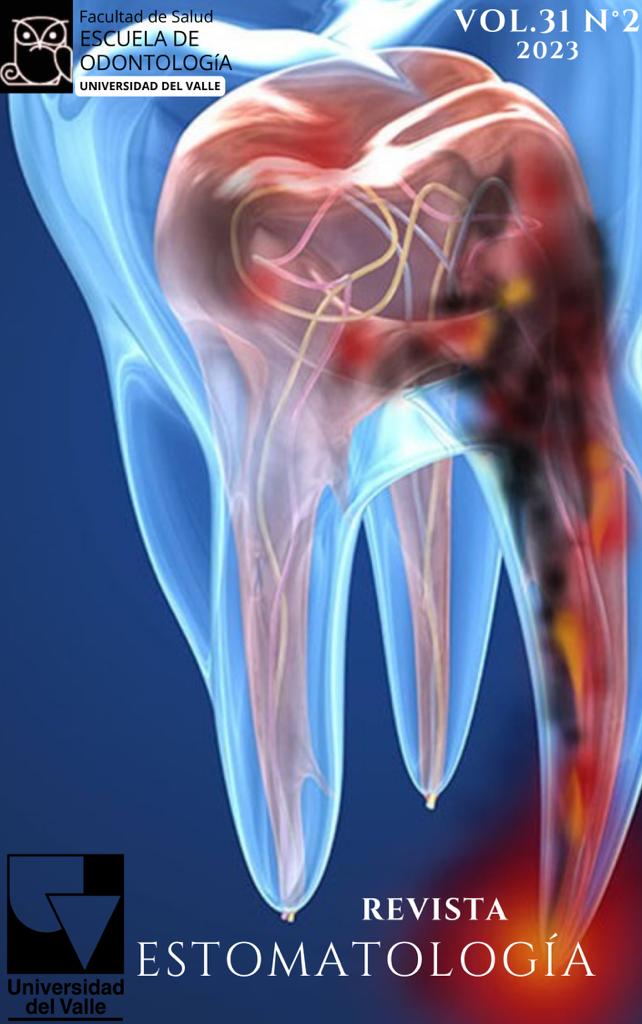Comparison of stresses and displacements between steel and titanium mini-implants inserted with different angles: finite element analysis.
Main Article Content
Objective: The objective of this study was to quantitatively evaluate the stresses and displacements of steel and titanium mini-implants inserted under different angles and applying a retraction force. Materials and Methods: A CAD model of the TD Orthodontics brand mini-implant, with a diameter of 1.3 mm and 8 mm length, was created. Afterwards, the characteristics of the materials to be evaluated (steel or titanium alloy) were assigned. A three-dimensional figure was created with two components that simulate the thickness and characteristics of cortical and trabecular bone (2 mm width of cortical bone and 18 mm depth of trabecular bone). The SolidWorks software was used to mesh the mini-implant and bone models and to perform the finite element analysis on the mini-implants with insertion angles of 30°, 60°, 90° and a simulated orthodontic retraction force of 2 N was applied on each of these finite element models. Results: In terms of the maximum von Mises stress in the different angles evaluated, it seems that there is no significant difference between the stainless steel mini-implants and the titanium mini-implants in the three angles evaluated. In terms of displacement, the titanium mini-implants in general suffered greater displacement in the three angles evaluated compared to the stainless steel mini-implants. Conclusion: Regardless of the angles, the difference in the generated stress and deformation in the stainless steel mini-implants and the titanium mini-implants under a retraction force of 2 N does not seem to be significant. Therefore, the insertion angle of the mini-implants seems to play a primary role in the amount of stress and deformation generated in the attachments used.
- orthodontics
- mini-implants
- finite elements
- tension
- displacement
Referencias
Liu WK, Li S, Park HS. Eighty years of the finite element method: Birth, evolution, and future. Arch Comput Methods Eng. 2022;1-23.
Stahl E, Keilig L, Abdelgader I, Jäger A, Bourauel C. Numerical analyses of biomechanical behavior of various orthodontic anchorage implants. J Orofac Orthop Kieferorthopädie. 2009;70(2):115-27.
Liu Y, Yang Z jin, Zhou J, Xiong P, Wang Q, Yang Y, et al. Comparison of anchorage efficiency of orthodontic mini-implant and conventional anchorage reinforcement in patients requiring maximum orthodontic anchorage: a systematic review and meta-analysis. J Evid Based Dent Pract. 2020;20(2):101401.
Casaña-Ruiz MD, Bellot-Arcís C, Paredes-Gallardo V, García-Sanz V, Almerich-Silla JM. Risk factors for orthodontic mini-implants in skeletal anchorage biological stability: a systematic literature review and meta-analysis. Sci Rep. 2020;10(1):1-10.
Tatli U, Alraawi M, Toroğlu MS. Effects of size and insertion angle of orthodontic mini-implants on skeletal anchorage. Am J Orthod Dentofacial Orthop. 2019;156(2):220-8.
Mešić E, Muratović E, Redžepagić-Vražalica L, Pervan N, Muminović AJ, Delić M, et al. Experimental & fem analysis of orthodontic mini-implant design on primary stability. Appl Sci. 2021;11(12):5461.
Redžepagić-Vražalica L, Mešić E, Pervan N, Hadžiabdić V, Delić M, Glušac M. Impact of implant design and bone properties on the primary stability of orthodontic mini-implants. Appl Sci. 2021;11(3):1183.
Asok N, Sing K, Tandon R, Chandra P. Retention of mini screws in orthodontics–a comparative in vitro study on the variables. South Eur J Orthod Dentofac Res. 2020;7(2):38-42.
Mazhari M, Khanehmasjedi M, Mazhary M, Atashkar N, Rakhshan V. Dynamics, Efficacies, and Adverse Effects of Maxillary Full-Arch Intrusion Using Temporary Anchorage Devices (Miniscrews): A Finite Element Analysis. BioMed Res Int. 2022;2022.
Kuroda S, Inoue M, Kyung HM, Koolstra JH, Tanaka E. Stress Distribution in Obliquely Inserted Orthodontic Miniscrews Evaluated by Three-Dimensional Finite-Element Analysis. Int J Oral Maxillofac Implants. 2017;32(2).
Sabley KH, Shenoy U, Banerjee S, Akhare P, Hazarey A, Karia H. Comparative Evaluation of Biomechanical Performance of Titanium and Stainless Steel Mini Implants at Different Angulations in Maxilla: A Finite Element Analysis. J Indian Orthod Soc. 2019;53(3):197-205.
Machado GL. Effects of orthodontic miniscrew placement angle and structure on the stress distribution at the bone miniscrew interface–A 3D finite element analysis. Saudi J Dent Res. 2014;5(2):73-80.
Arantes V de OR, Corrêa CB, Lunardi N, Boeck Neto RJ, Spin-Neto R, Boeck EM. Insertion angle of orthodontic mini-implants and their biomechanical performance: finite element analysis. Rev Odontol UNESP. 2015;44:273-9.
Perillo L, Jamilian A, Shafieyoon A, Karimi H, Cozzani M. Finite element analysis of miniscrew placement in mandibular alveolar bone with varied angulations. Eur J Orthod. 2015;37(1):56-9.
Sivamurthy G, Sundari S. Stress distribution patterns at mini-implant site during retraction and intrusion—a three-dimensional finite element study. Prog Orthod. 2016;17(1):1-11.
Brar LS, Dua VS. The magnitude and distribution pattern of stress on implant, teeth, and periodontium under different angulations of implant placement for en masse retraction: a finite element analysis. J Indian Orthod Soc. 2017;51(1):3-8.
Marcé-Nogué J, Walter A, Gil L, Puigdollers A. Finite element comparison of 10 orthodontic microscrews with different cortical bone parameters. Int J Oral Maxillofac Implants. 2013;28(4).
Kravitz ND, Kusnoto B. Risks and complications of orthodontic miniscrews. Am J Orthod Dentofacial Orthop. 2007;131(4):S43-51.
Liou EJ, Chen PH, Wang YC, Lin JCY. A computed tomographic image study on the thickness of the infrazygomatic crest of the maxilla and its clinical implications for miniscrew insertion. Am J Orthod Dentofacial Orthop. 2007;131(3):352-6.
Deguchi T, Nasu M, Murakami K, Yabuuchi T, Kamioka H, Takano-Yamamoto T. Quantitative evaluation of cortical bone thickness with computed tomographic scanning for orthodontic implants. Am J Orthod Dentofacial Orthop. 2006;129(6):721-e7.
Downloads
Accepted 2023-12-30
Published 2025-08-20

This work is licensed under a Creative Commons Attribution-NonCommercial-NoDerivatives 4.0 International License.
Los autores/as conservan los derechos de autor y ceden a la revista el derecho de la primera publicación, con el trabajo registrado con la licencia de atribución de Creative Commons, que permite a terceros utilizar lo publicado siempre que mencionen la autoría del trabajo y a la primera publicación en esta revista.





